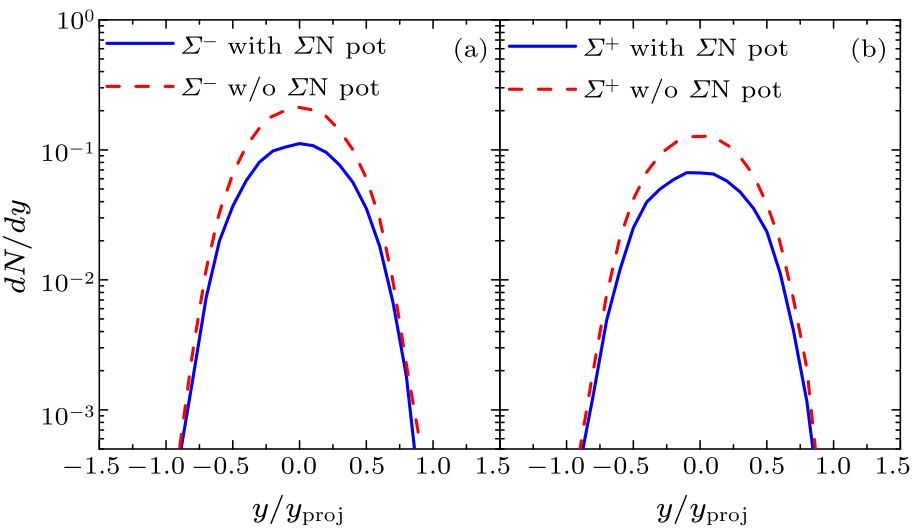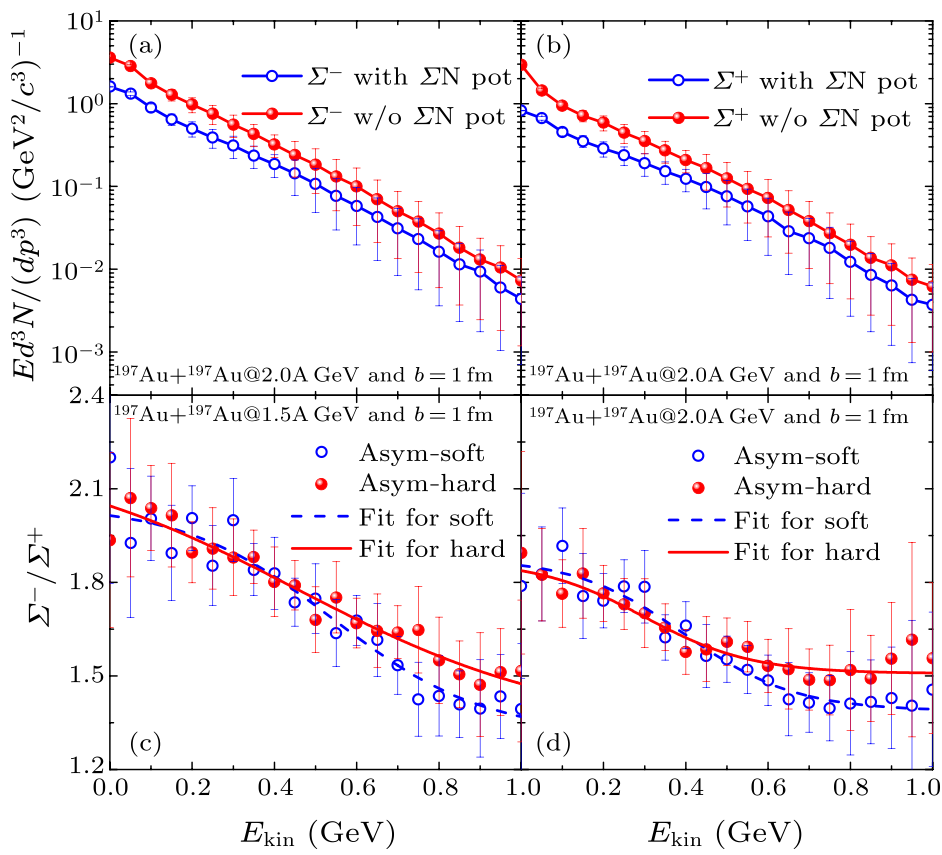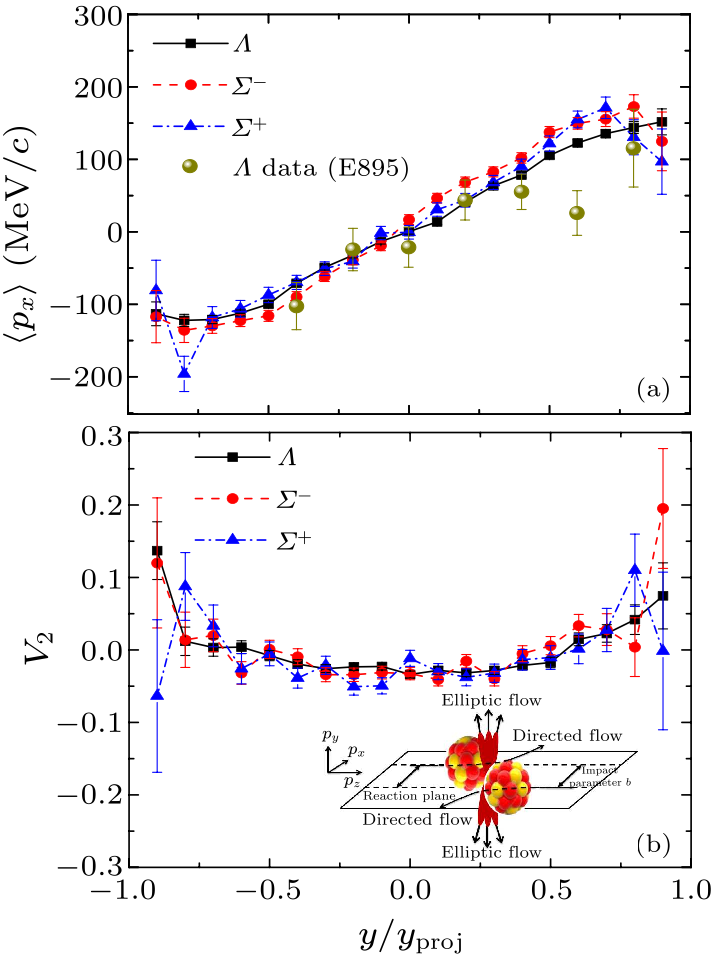
Fig. 1. (a) The density and (b) momentum dependence of hyperon-nucleon optical potential.

Fig. 2. The rapidity distribution of (a) $\varSigma^{-}$ and (b) $\varSigma^{+}$ in the central $^{197}$Au + $^{197}$Au collisions at an incident energy of 2 A GeV.
| Beam energy | Stiffness of symmetry energy | $\varLambda$ | $\varSigma^{-}$ | $\varSigma^{+}$ | $\varSigma^{0}$ | $\varSigma^{-}/\varSigma^{+}$ |
|---|---|---|---|---|---|---|
| 1.5 A GeV | Soft (with $\varSigma$N pot.) | 0.1008 | 0.0249 | 0.0143 | 0.0168 | 1.736 |
| 1.5 A GeV | Hard (with $\varSigma$N pot.) | 0.1002 | 0.0247 | 0.0141 | 0.0167 | 1.754 |
| 2 A GeV | Soft (with $\varSigma$N pot.) | 0.3813 | 0.1015 | 0.0627 | 0.0727 | 1.616 |
| 2 A GeV | Hard (with $\varSigma$N pot.) | 0.3777 | 0.1011 | 0.0619 | 0.0726 | 1.632 |
| Beam energy | YN potential | $\varLambda$ | $\varSigma^{-}$ | $\varSigma^{+}$ | $\varSigma^{0}$ | $\varSigma^{-}/\varSigma^{+}$ |
| 2 A GeV | Without potential | 0.6294 | 0.1694 | 0.1052 | 0.1232 | 1.610 |
| 2 A GeV | With potential | 0.3652 | 0.0918 | 0.0571 | 0.0683 | 1.607 |

Fig. 3. The kinetic spectra of (a) $\varSigma^{-}$ and (b) $\varSigma^{+}$ in the reaction of $^{197}$Au + $^{197}$Au at 2 A GeV with the $\varSigma$N potential and the isospin ratio $\varSigma^{-}/\varSigma^{+}$ with the different stiffness of symmetry energy in the reaction of $^{197}$Au + $^{197}$Au at (c) 1.5 A GeV and (d) 2 A GeV, respectively. The lines are shown for guiding the eyes.

Fig. 4. (a) The transverse and (b) elliptic flows of $\varLambda$, $\varSigma^{-}$ and $\varSigma^{+}$ in the $^{197}$Au + $^{197}$Au collisions at 2 A GeV. The experimental data of $\varLambda$ production from E895 Collaboration[40] are shown for comparison.
| [1] | Haidenbauer J and Meißner U G 2005 Phys. Rev. C 72 044005 | Jülich hyperon-nucleon model revisited
| [2] | Dai L R, Zhang Z Y, Yu Y W, and Wang P 2003 Nucl. Phys. A 727 321 | NN interactions in the extended chiral SU(3) quark model
| [3] | Fujiwara Y, Nakamoto C, Suzuki Y et al. 2004 Prog. Theor. Phys. Suppl. 156 17 | Quark-Model Baryon-Baryon Interaction and Its Applications to Hypernuclei
| [4] | Fujiwara Y, Suzuki Y, and Nakamoto C 2007 Prog. Part. Nucl. Phys. 58 439 | Baryon–baryon interactions in the
| [5] | Nagata J, Yoshino H, Limkaisang V et al. 2002 Phys. Rev. C 66 061001(R) | Phase-shift analysis of elastic scattering
| [6] | Kadowaki T, Asai J, Imoto W et al. 2002 Eur. Phys. J. A 15 295 | Asymmetry measurement of the polarized Σ+p elastic scattering and the hyperon-nucleon spin-orbit interaction
| [7] | Kondo Y, Ahn J K, Akikawa H et al. 2000 Nucl. Phys. A 676 371 | Σp elastic-scattering in the region of 400
| [8] | Rufa M, Schaffner J, Maruhn J et al. 1990 Phys. Rev. C 42 2469 | Multi-lambda hypernuclei and the equation of state of hypermatter
| [9] | Lombard Marcos S R J and Mareš J 1995 Phys. Rev. C 51 1784 | Description of hypernuclei in the scalar derivative coupling model
| [10] | Batty C J 1979 Phys. Lett. B 87 324 | Nuclear bound states of negatively charged hadrons?
| [11] | Gal A, Hungerford E V, and Millener D J 2016 Rev. Mod. Phys. 88 035004 | Strangeness in nuclear physics
| [12] | Dover C B, Millener D J, and Gal A 1989 Phys. Rep. 184 1 | On the production and spectroscopy of Σ hypernuclei
| [13] | Rijken T A, Nagels M M, and Yamamoto Y 2010 Nucl. Phys. A 835 160 | Status of understanding the YN/YY-interactions Meson-exchange viewpoint
| [14] | Petschauer S, Haidenbauer J, Kaiser N et al. 2016 Eur. Phys. J. A 52 15 | Hyperons in nuclear matter from SU(3) chiral effective field theory
| [15] | Haidenbauer J and Meißner U G 2015 Nucl. Phys. A 936 29 | A study of hyperons in nuclear matter based on chiral effective field theory
| [16] | Ga J H, Ma G L, Pu S et al. 2020 Nucl. Sci. Tech. 31 90 | Recent developments in chiral and spin polarization effects in heavy-ion collisions
| [17] | Lv H, Zhang S S, Zhang Z H et al. 2018 Chin. Phys. Lett. 35 062102 | Giant Monopole Resonance and Nuclear Incompressibility of Hypernuclei
| [18] | He Y J, Gu C C, Su J et al. 2020 Nucl. Sci. Tech. 31 84 | Study on deuteron formation mechanism in nucleon-induced reactions
| [19] | Xu Y, Zhi Q J, Wang Y B et al. 2019 Chin. Phys. Lett. 36 061301 | Nucleonic 1 S 0 Superfluidity Induced by a Soft Pion in Neutron Star Matter with Antikaon Condensations
| [20] | Weber F 2005 Prog. Part. Nucl. Phys. 54 193 | Strange quark matter and compact stars
| [21] | Jiang W Z, Li B A, Chen L W 2012 Astrophys. J. 756 56 | LARGE-MASS NEUTRON STARS WITH HYPERONIZATION
| [22] | Tsuruta S, Sadino J, Kobelski A et al. 2009 Astrophys. J. 691 621 | THERMAL EVOLUTION OF HYPERON-MIXED NEUTRON STARS
| [23] | Baldo M, Birgio G F, Schulze H J 2000 Phys. Rev. C 61 055801 | Hyperon stars in the Brueckner-Bethe-Goldstone theory
| [24] | Schaffner-Bielich J, Hanauske M, Stöcker H, and Greiner W 2002 Phys. Rev. Lett. 89 171101 | Phase Transition to Hyperon Matter in Neutron Stars
| [25] | Yan T Z, Li S, Wang Y N et al. 2019 Nucl. Sci. Tech. 30 15 | Yield ratios and directed flows of light particles from proton-rich nuclei-induced collisions
| [26] | Yang J C, Xia J W, Xiao G Q et al. 2013 Nucl. Instrum. Methods Phys. Res. Sect. B 317 263 | High Intensity heavy ion Accelerator Facility (HIAF) in China
| [27] | Pinkenburg C, Ajitanand N N, Alexander J M et al. 1999 Phys. Rev. Lett. 83 1295 | Elliptic Flow: Transition from Out-of-Plane to In-Plane Emission in Collisions
| [28] | Dönigus B 2013 Nucl. Phys. A 904–905 547c | (Anti-)matter and hyper-matter production at the LHC with ALICE
| [29] | Tamura H 2012 Prog. Theor. Exp. Phys. 2012 02B012 | Strangeness nuclear physics experiments at J-PARC
| [30] | Andronic A, Braun-Munzinger P, Stachel J et al. 2011 Phys. Lett. B 697 203 | Production of light nuclei, hypernuclei and their antiparticles in relativistic nuclear collisions
| [31] | Cugnon J, Deneye P, and Vandermeulen J 1989 Nucl. Phys. A 500 701 | Multipion dynamics following antiproton annihilation on nuclei
| [32] | Hartnack C, Oeschler H, Leifels Y, Bratkovskaya E, and Aichelin J 2012 Phys. Rep. 510 119 | Strangeness production close to the threshold in proton–nucleus and heavy-ion collisions
| [33] | Buss O et al. 2012 Phys. Rep. 512 1 | Transport-theoretical description of nuclear reactions
| [34] | Feng Z Q 2011 Phys. Rev. C 84 024610 | Momentum dependence of the symmetry potential and its influence on nuclear reactions
| [35] | Feng Z Q 2018 Nucl. Sci. Tech. 29 40 | Nuclear dynamics and particle production near threshold energies in heavy-ion collisions
| [36] | Feng Z Q 2012 Phys. Rev. C 85 014604 | Nuclear in-medium effects and collective flows in heavy-ion collisions at intermediate energies
| [37] | Feng Z Q 2013 Nucl. Phys. A 919 32 | Dynamics of strangeness and collective flows in heavy-ion collisions near threshold energies
| [38] | Li B A 2002 Phys. Rev. Lett. 88 192701 | Probing the High Density Behavior of the Nuclear Symmetry Energy with High Energy Heavy-Ion Collisions
| [39] | Li Q F, Li Z X, Zhao E G et al. 2005 Phys. Rev. C 71 054907 | ratio as a candidate for probing the density dependence of the symmetry potential at high nuclear densities
| [40] | Chung P, Ajitanand N N, Alexander J M et al. 2001 Phys. Rev. Lett. 86 2533 | Directed Flow of Hyperons in 2–6 GeV Collisions